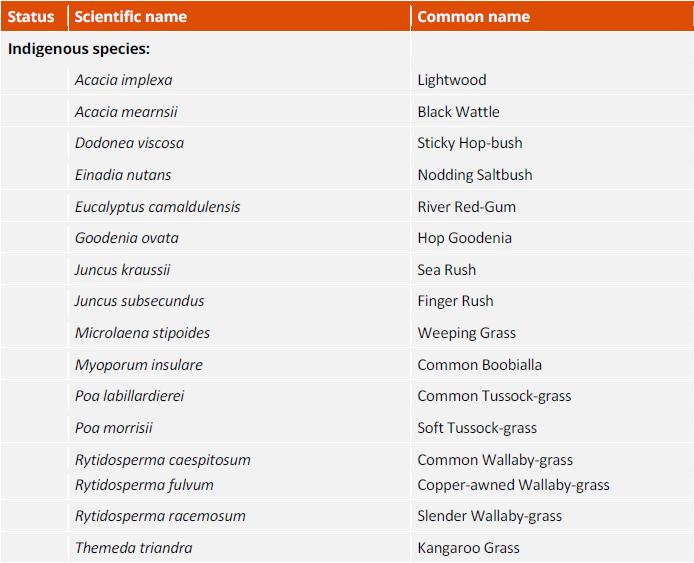The Yarra Link Project would like to thank the team at Biosis for their hard work at providing a full ecological and cultural survey of our Heyington location. We are very excited to move foward with the valuable knowledge and want to share a bit of what we’ve learned here.
We were very pleased to discover a number of indigenous plants already making their home on the site and providing the Yarra Link project with a place to begin work. The Diagram below details the indigenous plants found on the Yarra Link Project’s river-side location.
We have also received some valuable information regarding the cultural significance of a number of the plants that call the Yarra Link Project their home, below is what Biosis had to say regarding the use of some of these plants.
“Indigenous people of the Melbourne region used a diverse range of plants as a food source, for tools, adhesives, medicine and for cultural purposes. Following the removal of indigenous peoples from their land early in Australia’s history much of the information regarding indigenous use of plants has been gained from early European accounts and often the use of precise species can be difficult to establish (Gott 2008).
There are a number of plants currently present on the site that would have been commonly used by indigenous people in the area (reference):
River Red Gum trees were an important plant for indigenous people in the Melbourne area. The bark was used to make canoes, shelters, shields and containers. The sap was used to seal burns and was mixed with water to treat diarrhoea. The leaves were used in an aromatic steam bath to treat a range of ailments.
Black Wattle was an important source of gum. A sweet drink was made from the gum and flower nectar when dissolved in water. The gum was also used as a resin.
The leaves of Common Tussock-grass and Kangaroo Grass were used as string for nets, bags baskets and mats. The seeds from Kangaroo Grass were also ground into flour.
Prior to European settlement of the area the site may have contained a range of species that would have been used by local indigenous groups.
Plants with starchy tubers were commonly eaten and formed a significant portion of the diet of indigenous people (Gott 2008). Plants of this type that may have occurred within the study area include:
· Chocolate –lily Arthropodium spp.
· Marsh Club-sedge Bolboschoenus medianus
· Bulbine Lily Bulbine bulbosa
· Cranes-bill Geranium spp.
· Milkmaids Burchardia umbelata
· Common Reed Phragmites australis
· Plains Yam-Daisy Microseris scapigera
· Water Ribbons Triglochin spp.
Other local plant parts were utilised such as the berries of Spreading Flax-lily Dianella revoluta which were picked and eaten and the flowers of Native Violet Viola hederacea were picked and eaten raw.
Local aromatic plants such as mint Mentha spp. and Sneezeweed Centipeda spp. were widely used medicinally by indigenous groups. Materials with a high tannin content such as Eucalyptus sap were used to treat burns and wounds and local Mistletoe species Amyea sppm. were used in aromatic steam baths.
Several species commonly found in this area have known uses as materials for tools, adhesives and weapons. The stems of a number of species such as Poon’ort Carex tereticaulis and Spiny-headed Mat-rush Lomandra longifolia were spit and were woven into bags, baskets or nets. Blackwood Acacia melanoxylon was often used to make shields clubs or spear throwers.”
Reference:
Yarra Link Project: Flora and Fauna Assessment, Biosis Pty Ltd, Melbourne. Dec 2014.


Leave a Reply
You must be logged in to post a comment.